
2017 was an interesting year. I decided to go in a new direction this past year to focus on the WHY of learning and even started hosting a podcast. This post is about the blog posts I wrote. I always try to have hope and embrace joy when and where I can find it. Much of my love of learning is from my PLN. I have learned so much this year from amazing educators and wanted to share ideas and what I learned with you. In no particular order, here are the top 10 posts I wrote that were pretty popular on Twitter:
Build a Toolkit so Learners Become Future Ready
 Most teachers join the profession because they want to make a difference in children’s lives. They want their students to be the best they can be so they reach their fullest potential. But that is not always easy with large classroom sizes, a wide range of differences of the learners, and the constraints and barriers within the system. A Class Learning Snapshot (CLS) helps you design instructional and learning strategies based on four diverse learners in your class or classesby teaching to the extremes. What you come up with for the four learners helps you teach to the extremes instead of the average. Read more…
Most teachers join the profession because they want to make a difference in children’s lives. They want their students to be the best they can be so they reach their fullest potential. But that is not always easy with large classroom sizes, a wide range of differences of the learners, and the constraints and barriers within the system. A Class Learning Snapshot (CLS) helps you design instructional and learning strategies based on four diverse learners in your class or classesby teaching to the extremes. What you come up with for the four learners helps you teach to the extremes instead of the average. Read more…
Ikigai: Your Purpose and Reason for Being
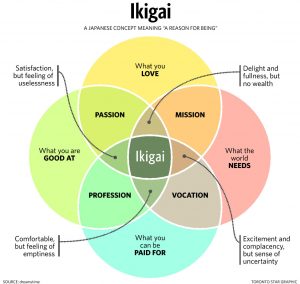 In a 2001 research paper on ikigai, co-author Akihiro Hasegawa, a clinical psychologist and associate professor at Toyo Eiwa University, placed the word ikigai as part of the everyday Japanese language. It is composed of two words: iki, which means life and gai, that describes value or worth. This is similar to passion but holds a strong “purposeful” connotation. The Japanese see the discovery of your ikigai as requiring a deep, long search within yourself that can bring about satisfaction and meaning to life. Ikigai has nothing to do with income. Start with these four primary elements to determine your reason for living:
In a 2001 research paper on ikigai, co-author Akihiro Hasegawa, a clinical psychologist and associate professor at Toyo Eiwa University, placed the word ikigai as part of the everyday Japanese language. It is composed of two words: iki, which means life and gai, that describes value or worth. This is similar to passion but holds a strong “purposeful” connotation. The Japanese see the discovery of your ikigai as requiring a deep, long search within yourself that can bring about satisfaction and meaning to life. Ikigai has nothing to do with income. Start with these four primary elements to determine your reason for living:
- What you Love (your passion)
- What the World Needs (your mission)
- What you are Good at (your vocation)
- What you can get Paid for (your profession)
Read more…
5 Tips to Make PBL Personal
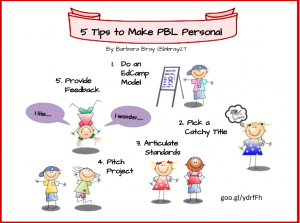 Project-based learning (PBL) incorporates the elements of learner-centered environments. When learners are encouraged to ask questions and have a voice about something they are interested in, now that’s more personal than traditional instruction! When kids have a chance to play, experiment, tinker, create, and do meaningful tasks, they are more motivated to want to learn. But it is not always that easy for teachers to transform lessons into project-based learning activities. The five tips to help teachers get started in making PBL personal include doing an Edcamp model, pick a catchy title, articulate standards, learn how to pitch the project, and have kids provide feedback. Read more…
Project-based learning (PBL) incorporates the elements of learner-centered environments. When learners are encouraged to ask questions and have a voice about something they are interested in, now that’s more personal than traditional instruction! When kids have a chance to play, experiment, tinker, create, and do meaningful tasks, they are more motivated to want to learn. But it is not always that easy for teachers to transform lessons into project-based learning activities. The five tips to help teachers get started in making PBL personal include doing an Edcamp model, pick a catchy title, articulate standards, learn how to pitch the project, and have kids provide feedback. Read more…
Defining Learner Agency
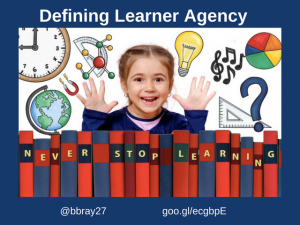 There is a significant and growing demand for learners to be able to do more than receiving instruction, follow a learning path designed by educators and complete problems and assignments presented to them by an adult. We have a sense of ‘agency’ when we feel in control of things that happen around us; when we feel that we can influence events. They must develop the capacity to engage strategically in their learning without waiting to be directed. They must take ownership of and responsibility for their learning. And, they must possess the skills to learn independently, without heavy dependence on external structures and direction. Read more…
There is a significant and growing demand for learners to be able to do more than receiving instruction, follow a learning path designed by educators and complete problems and assignments presented to them by an adult. We have a sense of ‘agency’ when we feel in control of things that happen around us; when we feel that we can influence events. They must develop the capacity to engage strategically in their learning without waiting to be directed. They must take ownership of and responsibility for their learning. And, they must possess the skills to learn independently, without heavy dependence on external structures and direction. Read more…
18 Ways to Recognize Learning as the Culture
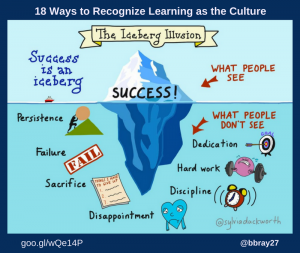 When you walk into your school, what do you see? Are kids motivated to learn? Do you see effort and persistence? Are teachers excited about all the kids in the school? Just as the Iceberg Illusion created by Sylvia Duckworth, @sylviaduckworth, shows, sometimes we only showcase success after learning has happened. For more of Sylvia’s graphics, go to her Flickr page. This post is about creating a culture of learning that is visible in your school as learning is happening. For learners to grow and flourish, we need to create learning environments where every child is recognized as a learner while they are learning. Some kids never get showcased or recognized. A culture that values every learner will empower them to discover the joy of learning. Read more…
When you walk into your school, what do you see? Are kids motivated to learn? Do you see effort and persistence? Are teachers excited about all the kids in the school? Just as the Iceberg Illusion created by Sylvia Duckworth, @sylviaduckworth, shows, sometimes we only showcase success after learning has happened. For more of Sylvia’s graphics, go to her Flickr page. This post is about creating a culture of learning that is visible in your school as learning is happening. For learners to grow and flourish, we need to create learning environments where every child is recognized as a learner while they are learning. Some kids never get showcased or recognized. A culture that values every learner will empower them to discover the joy of learning. Read more…
7 Ideas to Discover Magic in Your Classroom
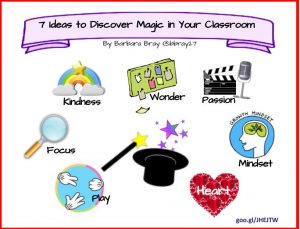 Yes, you can discover magic in your classroom right from the first day of school. Your kids are ready and willing to make magic happen if you are. Think of kindness, wonder, mindset, and the heart of learning as magical. We all need some magic in our lives. Why not in our classrooms? You can do that by bringing a sense of wonder to your classroom. One way is by building a wall of kindness. You can start by playing a game that makes everyone giggle. Share the difference between growth and fixed mindset. Find the heart in your classroom. Discover and share what you are passionate about. The magic is the culture in your classroom. Read more…
Yes, you can discover magic in your classroom right from the first day of school. Your kids are ready and willing to make magic happen if you are. Think of kindness, wonder, mindset, and the heart of learning as magical. We all need some magic in our lives. Why not in our classrooms? You can do that by bringing a sense of wonder to your classroom. One way is by building a wall of kindness. You can start by playing a game that makes everyone giggle. Share the difference between growth and fixed mindset. Find the heart in your classroom. Discover and share what you are passionate about. The magic is the culture in your classroom. Read more…
UDL and the Why of Learning
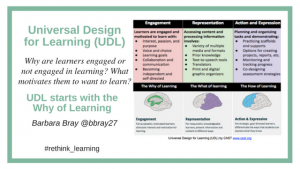 Universal Design for Learning (UDL) was developed by David Rose and Anne Meyer from CAST (Center for Applied Special Technology). The UDL principles are Multiple Means of Engagement, Multiple Means of Representation, and Multiple Means of Action & Expression. After learning more about UDL, I can see how UDL can be the framework for learning for all learners. I love that UDL starts with the why and how learners are engaged and motivated to learn. The WHY means what learners are interested in and passionate about. I decided to explore the UDL principles from my perspective as a learner. I know that I need to be motivated first about something new I want or need to learn. I’m kind of busy. There has to be a reason or purpose for my learning. Read more…
Universal Design for Learning (UDL) was developed by David Rose and Anne Meyer from CAST (Center for Applied Special Technology). The UDL principles are Multiple Means of Engagement, Multiple Means of Representation, and Multiple Means of Action & Expression. After learning more about UDL, I can see how UDL can be the framework for learning for all learners. I love that UDL starts with the why and how learners are engaged and motivated to learn. The WHY means what learners are interested in and passionate about. I decided to explore the UDL principles from my perspective as a learner. I know that I need to be motivated first about something new I want or need to learn. I’m kind of busy. There has to be a reason or purpose for my learning. Read more…
Design Thinking Process and UDL Planning Tool
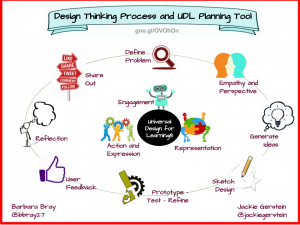 I wrote this post with Jackie Gerstein @jackiegerstein to go with our presentation at ISTE 2017. Some makerspace activities may be focusing on how to use the resources available and may not be connecting the activities to the curriculum or around a real world problem. If this is how the makerspace is set up in your school, then your kids may not have access to the resources, materials, and tools when they need them, especially for STEM or STEAM. In deciding what resources you need based on the learners you have, you may first need to determine how your learners learn best, what projects you plan to do, how you can set up a makerspace in your classroom, and much more. This is why we created a planning tool for makerspaces in the classroom using the Design Thinking Process and Universal Design for Learning (UDL). Read more…
I wrote this post with Jackie Gerstein @jackiegerstein to go with our presentation at ISTE 2017. Some makerspace activities may be focusing on how to use the resources available and may not be connecting the activities to the curriculum or around a real world problem. If this is how the makerspace is set up in your school, then your kids may not have access to the resources, materials, and tools when they need them, especially for STEM or STEAM. In deciding what resources you need based on the learners you have, you may first need to determine how your learners learn best, what projects you plan to do, how you can set up a makerspace in your classroom, and much more. This is why we created a planning tool for makerspaces in the classroom using the Design Thinking Process and Universal Design for Learning (UDL). Read more…
6 Ways Teachers Can Spread Intentional Positivity
 Being a teacher is the best job in the world. Just imagine all the children you impact and made a difference for every day. You may not get paid what you’re worth, but you probably would never do anything else. Right? So, why not start each day being grateful and positive for it. Consider “intentional positivity” means celebrating all the wonderful things happening in your class, school, and community. What can you do? Be happy! Keep a journal. Write Notes and send them home. Share with colleagues. Post stories. Read more…
Being a teacher is the best job in the world. Just imagine all the children you impact and made a difference for every day. You may not get paid what you’re worth, but you probably would never do anything else. Right? So, why not start each day being grateful and positive for it. Consider “intentional positivity” means celebrating all the wonderful things happening in your class, school, and community. What can you do? Be happy! Keep a journal. Write Notes and send them home. Share with colleagues. Post stories. Read more…
7 Strategies for Personal Professional Learning
 Professional learning encourages personal growth by teachers, but professional development (PD) programs have been designed around the “one size fits all” approach. A district may mandate that all teachers have to attend specific sessions around the district mission. Did the teachers have a voice in creating the mission? Teachers are learners too. What if teachers take charge of their own professional learning by reflecting on the process and demonstrating evidence of learning? It is all about owning the learning. When teachers identify and address what they need and want to learn and the school supports them by providing resources, people, and time, then that’s personal professional learning. Find out about the 7 strategies for your own personal professional learning. Read more...
Professional learning encourages personal growth by teachers, but professional development (PD) programs have been designed around the “one size fits all” approach. A district may mandate that all teachers have to attend specific sessions around the district mission. Did the teachers have a voice in creating the mission? Teachers are learners too. What if teachers take charge of their own professional learning by reflecting on the process and demonstrating evidence of learning? It is all about owning the learning. When teachers identify and address what they need and want to learn and the school supports them by providing resources, people, and time, then that’s personal professional learning. Find out about the 7 strategies for your own personal professional learning. Read more...
This coming year has my head spinning. I wake up and write in my journal ideas for new posts in the middle of the night. I’m excited about all the podcast conversations I’ve had. There are many I still need to edit and publish in the new year. They are amazing and I want to do a good job. I’m fortunate that my son, Andrew, is helping me edit the sound, find music, and make sure there are resources and links to complement the podcast. This takes time so there will be many podcasts being published soon. I so appreciate everyone in my PLN and all the awesome educators around the world who share the magic happening in their schools, their ideas, the books they wrote, and so much more. I am really looking forward to sharing more stories this coming year.
****
For all of the Rethinking Learning podcasts with Barbara Bray, click on the podcast tab at the top, the logo below, or go to https://barbarabray.net/podcasts/
Go to this page for resources, questions, and more information about Barbara’s new book, Define Your WHY.




